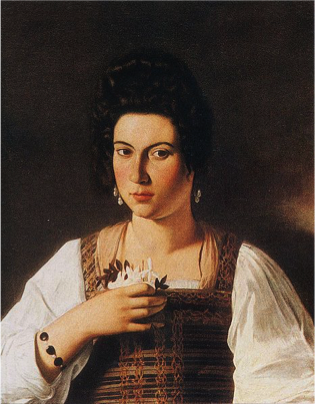
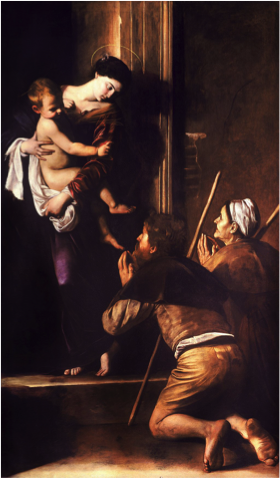 In 1500s Italy, art mostly glorified Biblical stories and the saints. Like many artists then, Caravaggio often hired prostitutes to pose for his paintings. But unlike most artists who used the women's features to paint works that conformed to the religious or moral expectations of the day, and conveyed a kind of ethereal beauty, Caravaggio brought in an element of realism that freaked out the establishment. His paintings do depict the expected stories and Biblical scenes—but with his own delicious twist: He painted the Virgin Mary with the face of a known prostitute, or with a little too much cleavage for comfort (as in his Madonna of Loreto, left). He dared to portray the Madonna as a normal woman, and even showed her bare feet. Horrors! "He had to know what the reaction was going to be, but it was like he couldn't help himself," says writer Tiffany Parks (ThePinesofRome.blogspot.com). "He couldn't sell out." Caravaggio wanted to show the truth, and his truth often involved Roman prostitutes.
In 1500s Italy, art mostly glorified Biblical stories and the saints. Like many artists then, Caravaggio often hired prostitutes to pose for his paintings. But unlike most artists who used the women's features to paint works that conformed to the religious or moral expectations of the day, and conveyed a kind of ethereal beauty, Caravaggio brought in an element of realism that freaked out the establishment. His paintings do depict the expected stories and Biblical scenes—but with his own delicious twist: He painted the Virgin Mary with the face of a known prostitute, or with a little too much cleavage for comfort (as in his Madonna of Loreto, left). He dared to portray the Madonna as a normal woman, and even showed her bare feet. Horrors! "He had to know what the reaction was going to be, but it was like he couldn't help himself," says writer Tiffany Parks (ThePinesofRome.blogspot.com). "He couldn't sell out." Caravaggio wanted to show the truth, and his truth often involved Roman prostitutes. 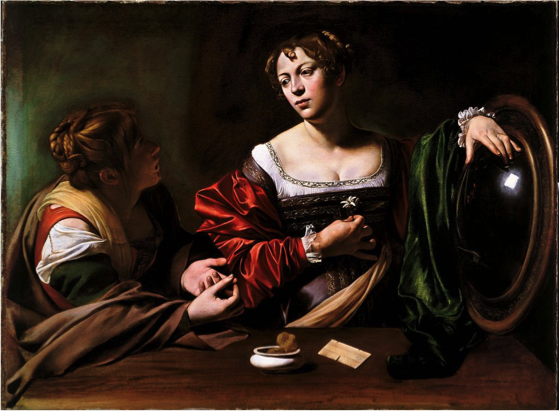 Also in 1598, both Fillide and Anna posed for the reckless but brilliant artist's Martha and Mary Magdalene. Fillide is on the right as Mary, while Anna likely sat for Martha.The painting exemplifies the irony in many of Caravaggio's works: He used prostitutes to represent the moment Mary Magdalene turned away from prostitution and was telling her sister Martha, who had devoted her life to God. While the women are depicted realistically, down to Fillide's slightly crooked finger, neither she nor Anna was likely to give up her work to follow the Almighty.
Also in 1598, both Fillide and Anna posed for the reckless but brilliant artist's Martha and Mary Magdalene. Fillide is on the right as Mary, while Anna likely sat for Martha.The painting exemplifies the irony in many of Caravaggio's works: He used prostitutes to represent the moment Mary Magdalene turned away from prostitution and was telling her sister Martha, who had devoted her life to God. While the women are depicted realistically, down to Fillide's slightly crooked finger, neither she nor Anna was likely to give up her work to follow the Almighty.
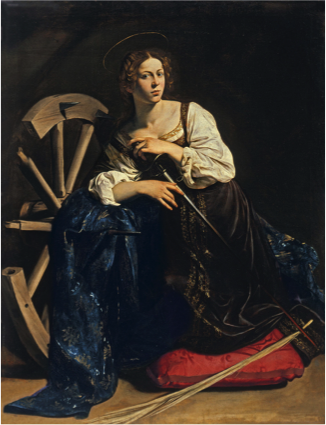 for assault with two other prostitutes, writes Graham-Dixon. She reportedly attacked another whore with a knife and had to be restrained. One witness said Fillide shouted at the woman, "Whore, I'm going to scar you everywhere."Just two years earlier, Fillide had posed for Caravaggio's fearsome and beautiful St. Catherine. She'd also modeled for his visceral and bloody Judith Beheading Holofernes.
for assault with two other prostitutes, writes Graham-Dixon. She reportedly attacked another whore with a knife and had to be restrained. One witness said Fillide shouted at the woman, "Whore, I'm going to scar you everywhere."Just two years earlier, Fillide had posed for Caravaggio's fearsome and beautiful St. Catherine. She'd also modeled for his visceral and bloody Judith Beheading Holofernes. 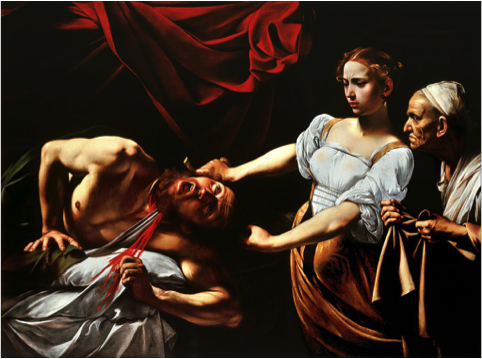 But the realism of paintings like these horrified the establishment. They were too real for comfort. Locals may have read in the papers that Fillide was often in trouble with the law and recognized her in the painting. What's more, her pimp was likely Ranuccio Tomassoni, and here the plot thickens: Tomassoni is the man Caravaggio murdered in 1606, forcing the artist to flee Rome. Her assault arrest in 1600 may have involved a fight between the women over Ranuccio.
But the realism of paintings like these horrified the establishment. They were too real for comfort. Locals may have read in the papers that Fillide was often in trouble with the law and recognized her in the painting. What's more, her pimp was likely Ranuccio Tomassoni, and here the plot thickens: Tomassoni is the man Caravaggio murdered in 1606, forcing the artist to flee Rome. Her assault arrest in 1600 may have involved a fight between the women over Ranuccio.
 But in 1604's The Entombment (now in the Vatican's picture gallery), Fillide, now 22, reappears, posing for both Mary Magdalene and another woman, who weep beside the Madonna.A Deadly Rivalry
Two years later, on the evening of Sunday, May 28, 1606, Caravaggio killed Ranuccio Tomassoni. Could Fillide have played into the deadly animosity between the two men? Perhaps. Graham-Dixon argues that Caravaggio moonlighted as a pimp—what better way to be sure he had models at his disposal? Had he tried to steal Fillide from Ranuccio, inflaming a rivalry between the two men? The usual story says the men fought over a tennis match, but Graham-Dixon disagrees, writing that it was only a ruse to set up a duel over slighted honor.Caravaggio fled Rome, and sadly died in 1610 while on his way back to the city having finally secured a pardon. Anna had died in 1604, Ranuccio followed and now Fillide was the last woman standing in this strange circle of friends and rivals. Surprisingly, given her life and the life expectancy of most prostitutes at the time—25 years—Fillide lived into her late thirties.
But in 1604's The Entombment (now in the Vatican's picture gallery), Fillide, now 22, reappears, posing for both Mary Magdalene and another woman, who weep beside the Madonna.A Deadly Rivalry
Two years later, on the evening of Sunday, May 28, 1606, Caravaggio killed Ranuccio Tomassoni. Could Fillide have played into the deadly animosity between the two men? Perhaps. Graham-Dixon argues that Caravaggio moonlighted as a pimp—what better way to be sure he had models at his disposal? Had he tried to steal Fillide from Ranuccio, inflaming a rivalry between the two men? The usual story says the men fought over a tennis match, but Graham-Dixon disagrees, writing that it was only a ruse to set up a duel over slighted honor.Caravaggio fled Rome, and sadly died in 1610 while on his way back to the city having finally secured a pardon. Anna had died in 1604, Ranuccio followed and now Fillide was the last woman standing in this strange circle of friends and rivals. Surprisingly, given her life and the life expectancy of most prostitutes at the time—25 years—Fillide lived into her late thirties.
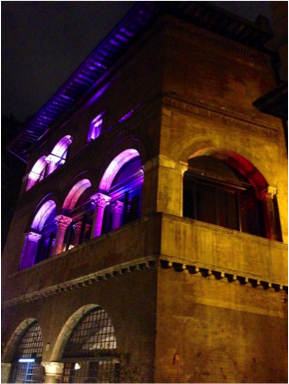 By 1618, Graham-Dixon reports she had her own house, which may have looked like one of the few courtesan's houses still standing in Rome. But she was very ill, perhaps with a venereal disease, and she died in July of that year.Fillide left a will behind in which she stated she wanted her estate sold off. She left some money to religious institutions dedicated to the Virgin, as well as to the Convertite—religious houses where reformed prostitutes could go to escape life on the street. But she asked that the portrait Caravaggio had made of her when she was a young girl of 17, and now was in her estate, should go to her former lover, Giulio Strozzi.
By 1618, Graham-Dixon reports she had her own house, which may have looked like one of the few courtesan's houses still standing in Rome. But she was very ill, perhaps with a venereal disease, and she died in July of that year.Fillide left a will behind in which she stated she wanted her estate sold off. She left some money to religious institutions dedicated to the Virgin, as well as to the Convertite—religious houses where reformed prostitutes could go to escape life on the street. But she asked that the portrait Caravaggio had made of her when she was a young girl of 17, and now was in her estate, should go to her former lover, Giulio Strozzi.

2/26/2016

2/26/2016

2/26/2016


2/26/2016

2/26/2016